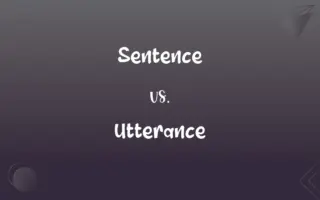Ideal Solution vs. Non Ideal Solution: What's the Difference?
Edited by Janet White || By Harlon Moss || Updated on October 19, 2023
An ideal solution follows Raoult's law with components having similar intermolecular forces, while a non-ideal solution deviates from this law.

Key Differences
An ideal solution is a mixture of solvents and solutes that obeys Raoult's law across all concentrations. This means that the vapor pressure of each component in the solution is directly proportional to its mole fraction. A non-ideal solution, on the other hand, deviates from Raoult's law.
The formation of an ideal solution is accompanied by neither absorption nor evolution of heat. In contrast, the formation of a non-ideal solution may result in the absorption or release of heat, indicating interactions differing from those in the pure components.
In an ideal solution, there is no volume change upon mixing; the total volume of the solution is equal to the sum of the volumes of its components. This is not the case for a non-ideal solution, where the volume may increase or decrease upon mixing.
Intermolecular forces between like and unlike molecules are equal in ideal solutions. This means the forces between A-A and B-B molecules are similar to those between A-B molecules. However, in non-ideal solutions, the intermolecular forces between like and unlike molecules are different, leading to deviations from ideal behavior.
While ideal solutions are largely theoretical and are rarely observed in practice, they provide a useful reference for understanding solution behaviors. Non-ideal solutions are more common in real-world scenarios, as most real mixtures exhibit deviations from Raoult's law to some extent.
ADVERTISEMENT
Comparison Chart
Raoult's Law
Obeys Raoult's law at all concentrations
Deviates from Raoult's law
Heat of Mixing
No heat absorption or evolution
Heat may be absorbed or released
Volume Change upon Mixing
No volume change
Volume may increase or decrease
Intermolecular Forces
A-A and B-B forces similar to A-B forces
A-A and B-B forces different from A-B forces
Real or Theoretical
Largely theoretical
More common in real-world scenarios
ADVERTISEMENT
Ideal Solution and Non Ideal Solution Definitions
Ideal Solution
A mixture where the total volume is the sum of the volumes of its components.
When two truly miscible liquids are mixed, they may form an ideal solution if there's no volume change.
Non Ideal Solution
A mixture where intermolecular forces between different molecules differ from those of like molecules.
A non-ideal solution often forms when components have different types of intermolecular attractions.
Ideal Solution
A mixture with neither heat absorption nor evolution upon mixing.
Combining two components to create an ideal solution won't result in any temperature change.
Non Ideal Solution
A solution that might release or absorb heat upon mixing.
When the mixture becomes warm or cool spontaneously, it's likely a non-ideal solution.
Ideal Solution
A theoretical solution used as a reference in thermodynamics.
Chemists often compare real solutions to an ideal solution to understand deviations.
Non Ideal Solution
A solution that deviates from Raoult's law.
When mixing acetone and chloroform, one gets a non-ideal solution with negative deviations.
Ideal Solution
A solution where intermolecular forces between like and unlike molecules are similar.
In an ideal solution, attractions between different types of molecules resemble those within the same type.
Non Ideal Solution
A mixture where the total volume upon mixing isn't the sum of the component volumes.
The unexpected shrinkage when combining two liquids indicates a non-ideal solution.
Ideal Solution
A solution that obeys Raoult's law across all concentrations.
An equimolar mixture of benzene and toluene comes close to being an ideal solution.
Non Ideal Solution
A real-world solution exhibiting deviations from ideal behavior.
Most solutions in nature are non-ideal solutions, deviating from theoretical predictions.
FAQs
Are real-life solutions more often ideal or non-ideal?
Most real-life solutions are non-ideal solutions, with ideal solutions being largely theoretical.
Is there any heat change in an ideal solution upon mixing?
No, an ideal solution has no heat change upon mixing, unlike non-ideal solutions.
Are there positive and negative deviations in non-ideal solutions?
Yes, non-ideal solutions can show positive or negative deviations from Raoult's law, unlike consistent ideal solutions.
What is an ideal solution?
An ideal solution is one that obeys Raoult's law across all concentrations, unlike a non-ideal solution.
What happens to the volume in a non-ideal solution when mixed?
In a non-ideal solution, volume may increase or decrease upon mixing, unlike an ideal solution.
Can non-ideal solutions lead to azeotropes?
Yes, non-ideal solutions can lead to azeotropes, which are not seen in ideal solutions.
What's the significance of intermolecular forces in ideal solutions?
In ideal solutions, the intermolecular forces between like and unlike molecules are similar, unlike non-ideal solutions.
How do deviations in non-ideal solutions help in industrial processes?
Deviations in non-ideal solutions can be exploited for separations in industries, unlike consistent ideal solutions.
Can deviations in non-ideal solutions be measured?
Yes, deviations in non-ideal solutions can be measured using various techniques, providing insights not necessary in ideal solutions.
Are the solute-solvent interactions always ideal?
No, in many cases, solute-solvent interactions lead to non-ideal solutions rather than ideal solutions.
How are ideal solutions useful in chemical engineering?
Ideal solutions help in designing processes and predicting behaviors, though real systems often behave as non-ideal solutions.
Can non-ideal solutions have components that are immiscible?
Yes, non-ideal solutions can have components that are partially or completely immiscible, unlike consistently miscible ideal solutions.
Do ideal solutions exist in nature?
While some solutions come close, truly ideal solutions are rare, with most being non-ideal.
What drives the formation of a non-ideal solution?
Non-ideal solutions form due to differences in intermolecular forces between the components, unlike ideal solutions.
Are colligative properties affected in non-ideal solutions?
Yes, colligative properties can deviate in non-ideal solutions compared to ideal solutions.
Is the entropy change always predictable in non-ideal solutions?
Not always. The entropy change in non-ideal solutions might vary, unlike the predictable behavior in ideal solutions.
Do non-ideal solutions always deviate from Raoult's law?
Yes, non-ideal solutions deviate from Raoult's law, while ideal solutions obey it.
Why do non-ideal solutions show volume changes upon mixing?
Non-ideal solutions show volume changes due to differences in intermolecular forces, unlike ideal solutions.
How do ideal solutions aid in understanding solution behaviors?
Ideal solutions provide a reference to understand deviations in non-ideal solutions.
Why are ideal solutions important in thermodynamics?
Ideal solutions provide a reference point for understanding deviations in real, non-ideal solutions.
About Author
Written by
Harlon MossHarlon is a seasoned quality moderator and accomplished content writer for Difference Wiki. An alumnus of the prestigious University of California, he earned his degree in Computer Science. Leveraging his academic background, Harlon brings a meticulous and informed perspective to his work, ensuring content accuracy and excellence.
Edited by
Janet WhiteJanet White has been an esteemed writer and blogger for Difference Wiki. Holding a Master's degree in Science and Medical Journalism from the prestigious Boston University, she has consistently demonstrated her expertise and passion for her field. When she's not immersed in her work, Janet relishes her time exercising, delving into a good book, and cherishing moments with friends and family.































































